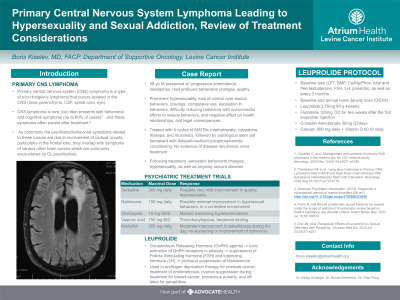Psycho-Oncology and Palliative Care
(122) Primary Central Nervous System Lymphoma Leading to Hypersexuality and Sexual Addiction, Review of Treatment Considerations and Use of Leuprolide for Hypersexuality


Boris Kiselev, MD, FACP (he/him/his)
Assistant Professor
Atrium Health
Charlotte, North Carolina
Boris Kiselev, MD, FACP (he/him/his)
Assistant Professor
Atrium Health
Charlotte, North Carolina
Presenting Author(s)
Background/Significance
Primary central nervous system (CNS) lymphoma is a type of non-Hodgkin’s lymphoma that occurs isolated in the CNS (brain parenchyma, CSF, spinal cord, eye). CNS lymphoma is rare, but often presents with behavioral and cognitive symptoms (up to 60% of cases)1 , and these symptoms often persist after treatment.3 As commonly the psychiatric/behavioral symptoms related to these tumors are due to involvement of cortical circuits, particularly in the frontal lobe, they overlap with symptoms of various other brain tumors which are commonly encountered by CL psychiatrists.
Methods
We will discuss a 58 yo M who presented with progressive somnolence, headaches, as well as profound behavioral changes and was ultimately diagnosed with a left frontal lobe CNS lymphoma. The patient also experienced extremely prominent hypersexuality. Though sexual addiction is not a specific diagnosis in the DSM-V4, the patient met all criteria for a severe non-substance-related addictive disorder. He experienced marked loss of control over sexual behaviors, cravings, compulsive use, escalation in behaviors, difficulty reducing behaviors with unsuccessful efforts to reduce behaviors, and negative effect on health, relationships, and legal consequences. I will review the patient's treatment course which included chemotherapy followed by an autologous stem cell transplant. Following treatment he had persistent behavioral symptoms including hypersexuality, for which I will review psychiatric treatment trials used in his treatment, as well as review the literature on hypersexuality in CNS malignancies.
Results
Patient was trialed on numerous classes of medications including SSRIs, antipsychotics, mood stabilizers, naltrexone and ultimately was placed on GnRH agonist Leuprolide for suppression of hypothalamic–pituitary–gonadal axis. This form of has been used in patients with paraphilias5, however, it is associated with numerous side effects including reduced bone density, hot flashes, dyslipidemia, and weight gain. A protocol for administration of leuprolide for compulsive sexual behaviors, as well as monitoring, will be reviewed.
Discussion/Conclusion/Implications
Considering the variety of neural circuits that can be affected by CNS malignancies, the behavioral and psychiatric symptoms of these tumors can be varied, and approach to treatment is often based on symptom profile. Evidence is often limited to case reports and series, and this case adds important information to the literature regarding both specific symptoms that can occur in the setting of CNS lymphoma, as well as approaches to treatment of hypersexuality arising from neurological insults.
References
1 Houillier C, et.al. Management and outcome of primary CNS lymphoma in the modern era: An LOC network study. Neurology. 2020 Mar 10;94(10):e1027-e1039.
2Therkelsen KE et.al.. Long-term Outcomes in Primary CNS Lymphoma After R-MVP and High-Dose Chemotherapy With Autologous Hematopoietic Stem Cell Transplant. Neurology. 2023 Aug 15;101(7):e710-e716.
3American Psychiatric Association. (2013). Diagnostic and statistical manual of mental disorders (5th ed.). https://doi.org/10.1176/appi.books.9780890425596
4 Pistre N, etal Should problematic sexual behavior be viewed under the scope of addiction? A systematic review based on DSM-5 substance use disorder criteria. Addict Behav Rep. 2023 Jul 16;18:100510.
5 Choi JH, et al Therapeutic Effects of Leuprorelin in Sexual Offenders with Paraphilia. J Korean Med Sci. 2018 Jul 23;33(37):e231.
Presentation Eligibility: Not previously published or presented
Diversity, Equity, and Inclusion: Patients with addictive disorders, and in addition patients with sexual disorders are stigmatized in the general population as well as in the medical setting. Awareness towards the etiologies of these disorders, and in cases where there is a neurological basis understanding of the mechanisms of these symptoms can increase awareness, and reduce stigma and bias towards these patient populations.

